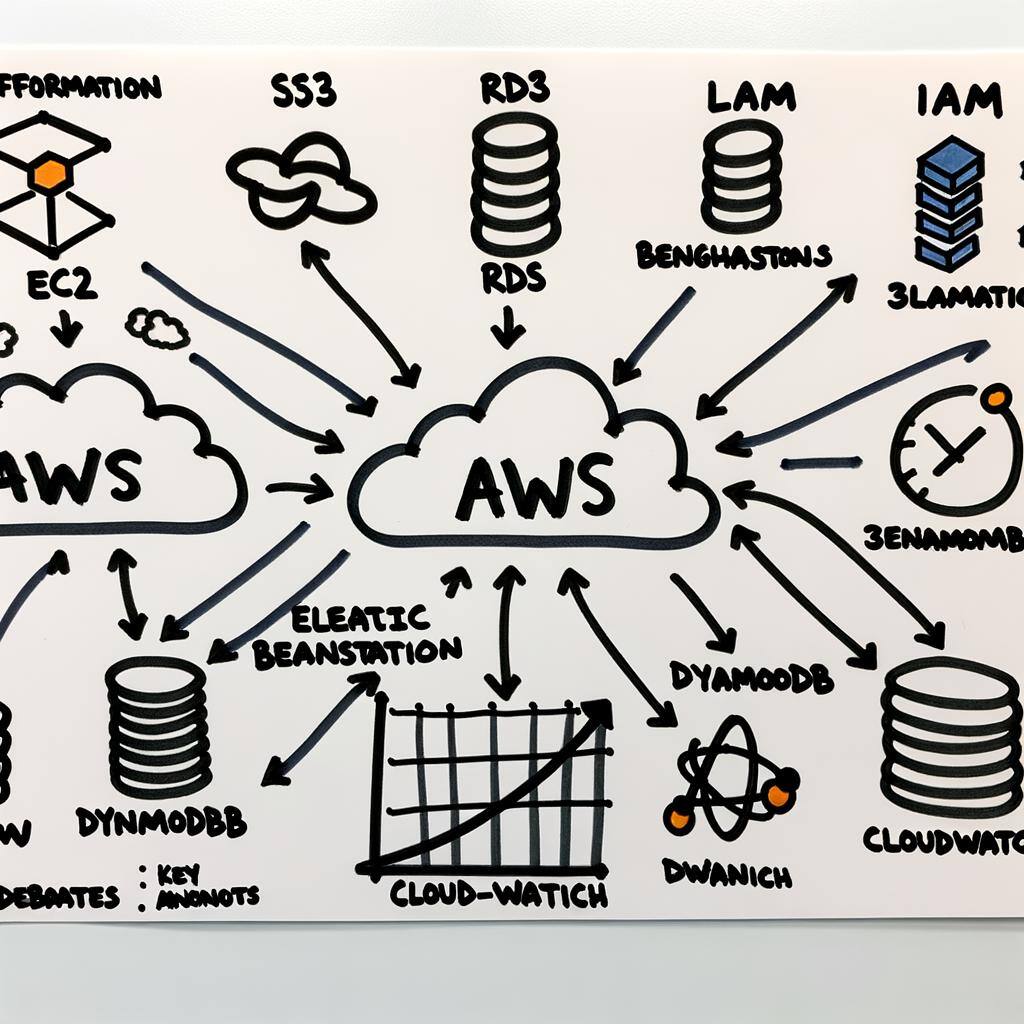1 min read
Top AWS Tools Every Startup Should Consider for Effective Development
Introduction In the fast-paced world of startups, having the right tools can make all the difference in product development. Amazon Web Services...
6 min read
 Ed Soltani
:
June 30, 2024 at 9:03 PM
Ed Soltani
:
June 30, 2024 at 9:03 PM

When it comes to revolutionising the way businesses handle their computational workloads, AWS Lambda stands at the forefront of serverless technology. As a CTO, CIO, Solutions Architect, or Founder, you’re always on the lookout for efficient, cost-effective solutions that don’t compromise on performance or scalability. AWS Lambda offers precisely that by allowing you to run code without provisioning or managing servers, freeing you to focus on innovation and strategic growth.
AWS Lambda is a serverless compute service that automatically scales your applications in response to incoming demand, ensuring that you only pay for the compute time you consume. Imagine no more idle servers costing you money and no more worrying about scaling issues during peak times. This means significant cost savings and operational efficiency for any tech-driven enterprise.
In this guide, we'll explore the intricacies of AWS Lambda, including its powerful features, real-world applications, and the substantial benefits it offers. From enhancing your application's performance to reducing overhead costs, AWS Lambda is transforming how modern businesses operate in the digital landscape.
AWS Lambda is not just powerful on its own but becomes even more versatile when integrated with other AWS services. This section explores how AWS Lambda can be used seamlessly with Amazon S3, Amazon DynamoDB, and Amazon API Gateway to enhance your applications' functionality and efficiency.
AWS Lambda can be triggered by events occurring in Amazon S3, making it a great solution for automating workflows based on changes in S3.
When a new object is created or an existing one is deleted in an S3 bucket, a Lambda function can be automatically invoked to handle these events. For instance, you can automatically generate thumbnails for images uploaded to an S3 bucket, or process log files as soon as they're added.
To set this up:
For further information on setting up this integration, you can read more on Processing Amazon S3 Event Notifications with Lambda.
Integrating AWS Lambda with Amazon DynamoDB enables real-time data processing, providing a robust solution for applications that require immediate actions upon data changes.
With DynamoDB Streams, changes to data in your DynamoDB tables (like inserts, updates, and deletes) can automatically trigger a Lambda function. This setup is ideal for:
To start:
You can find a step-by-step guide on the DynamoDB Streams and AWS Lambda Triggers page.
By combining AWS Lambda with Amazon API Gateway, you can build scalable and robust APIs quickly and easily. API Gateway acts as a front door for applications to access data, business logic, or functionality from your backend services.
Here's how it works:
This setup helps you manage high-volume requests efficiently and securely, with API Gateway handling the scaling and Lambda processing the tasks. Learn more about this in the Tutorial: Using Lambda with API Gateway.
By integrating AWS Lambda with these services, you can automate tasks, process data in real time, and create scalable, efficient APIs. Each combination unlocks new potentials for your applications, enhancing performance while reducing manual efforts and operational costs.
AWS Lambda has revolutionised how businesses handle computational workloads by offering a serverless solution that scales automatically. This section explores practical applications of AWS Lambda, highlighting its versatility and efficiency in various real-world scenarios.
AWS Lambda excels at data processing tasks, enabling businesses to handle large volumes of data efficiently.
Examples of data processing applications using AWS Lambda include:
Automating backups and system maintenance ensures business continuity and data integrity without manual intervention.
Here's how AWS Lambda can handle these tasks:
AWS Lambda is a cornerstone for building serverless applications, enabling developers to create robust and scalable applications quickly.
To build a complete serverless application with AWS Lambda:
In summary, AWS Lambda offers robust solutions for data processing, automated backups, and building serverless applications, making it an indispensable tool for modern enterprises aiming for efficiency and scalability.
Understanding the pros and cons of AWS Lambda can help you determine if it's the right choice for your business operations. This section dives into the benefits and potential drawbacks, giving you a complete picture.
AWS Lambda offers several key benefits that make it an attractive option for many businesses. Here are some of the most notable advantages:
Cost Efficiency: With AWS Lambda, you only pay for the compute time you actually use. There are no charges when your code isn't running, which can lead to significant cost savings compared to traditional server-based models. Learn more about how cost-effective Lambda is in the AWS Lambda Pricing Guide.
Scalability: Lambda automatically adjusts its capacity to handle incoming requests. This means you don't need to worry about provisioning resources or dealing with server management, as your applications will scale seamlessly with traffic.
Ease of Use: AWS Lambda is designed to be user-friendly, enabling quick deployment of functions without the need for extensive configuration. It integrates smoothly with other AWS services like DynamoDB and S3, making it a versatile tool in your cloud infrastructure. For a deeper dive, refer to the AWS Lambda Overview.
Event-Driven Architecture: Lambda's ability to trigger functions in response to events allows for more responsive and efficient applications. Whether it's data changes, HTTP requests, or file uploads, Lambda handles it effectively.
No Server Management: One of the biggest advantages is the elimination of server management tasks. With AWS Lambda, there is no need to worry about server maintenance, patching, or monitoring, reducing the operational burden on your IT team.
Supports Multiple Languages: Lambda functions can be written in various programming languages such as Java, Python, Node.js, and more, giving developers the flexibility to use the language they are most comfortable with. For more information, check the Lambda Language Support page.
Despite its numerous benefits, AWS Lambda does have some limitations that you should be aware of before fully integrating it into your operations:
Cold Start Latency: One common issue is the latency associated with "cold starts," which occurs when a function is invoked after being idle. This can lead to slower response times during the initial invocation. For more details, see the discussion on cold starts.
Vendor Lock-In: Since Lambda functions are tightly integrated with the AWS ecosystem, it can be challenging to migrate to other platforms. This dependency can limit flexibility and lead to higher switching costs.
Limited Execution Duration: AWS Lambda imposes a maximum execution timeout of 15 minutes for any given function. This can be a constraint for applications requiring longer processing times. More on this can be found in the AWS Lambda Limits.
Resource Constraints: Each Lambda function is limited in terms of memory and storage. Complex applications may require higher resources, necessitating alternative solutions like EC2 instances or Fargate. Explore more in the Resource Model for AWS Lambda.
Complex Orchestration: While Lambda is great for simple tasks, orchestrating complex workflows can be challenging and might require additional services like AWS Step Functions to manage dependencies and sequence. Check out Step Functions for more on orchestrating workflows.
Considering both the advantages and limitations of AWS Lambda ensures that you make an informed decision, leveraging its strengths while planning for its potential drawbacks.

1 min read
Introduction In the fast-paced world of startups, having the right tools can make all the difference in product development. Amazon Web Services...

Pros of Using AWS Amplify When discussing the benefits of AWS Amplify, it's clear that its ease of integration, scalability, and development speed...

Migrating to AWS can feel overwhelming, but hiring an AWS Managed Service Provider (MSP) simplifies the entire process. You might wonder if this step...